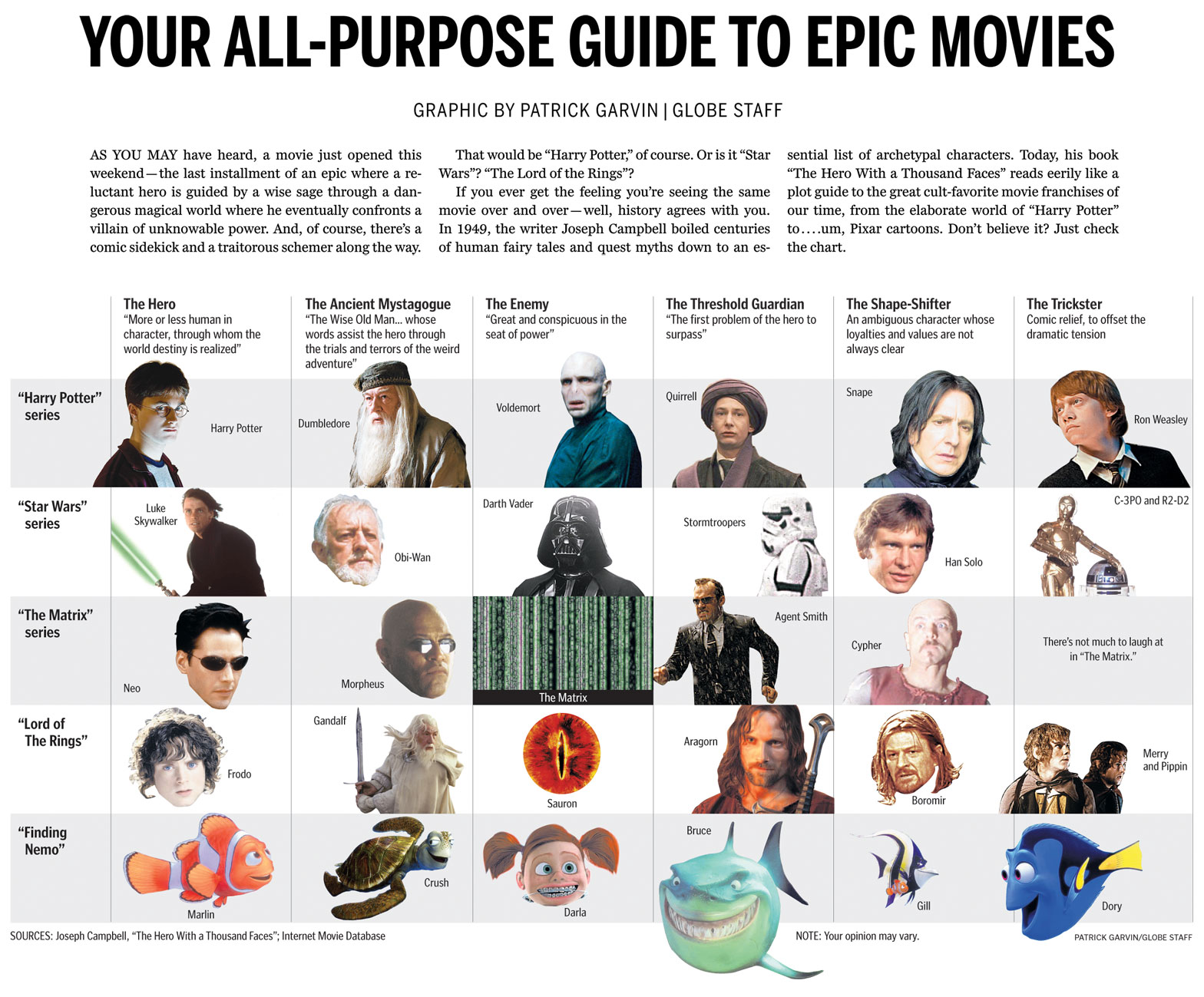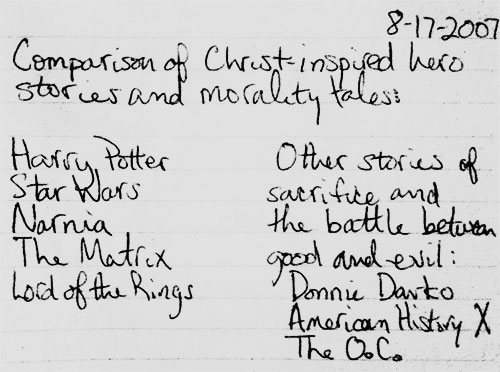I wanted to share with you a chart from the Ideas section of this Sunday’s Boston Globe. Using the archetypes described in Joseph Campbell’s “The Hero With a Thousand Faces,” the chart compares characters from the Harry Potter series, “Star Wars,” “The Matrix,” “Lord Of The Rings” and… “Finding Nemo.”
Click for a larger view.
—
HOW IT CAME TOGETHER
I’ve long kept a graphics notebook in which I jot down and scribble ideas as they occur to me. I’m currently on the fifth notebook.
In the summer of 2007, I caught up with the world and finally began reading the Harry Potter books. I started a month or so before the final book was released. Thus, I got to start with the first book and read the entire series without pausing in between books. The day I finished the seventh book, my mind was racing with ideas. Once such idea:
I jotted whatever came to my mind, knowing I could edit it later. I had long seen the similarities in other sci-fi and fantasy movies, as I had some teachers in high school who riffed on those concepts in class. The idea sat in the notebook for almost four years. (Note to those who know me: check the date on the top of the notebook entry.)
Flash forward to this current summer, four years and one newspaper after I first read the Harry Potter books and had the idea. Colleague Ryan Huddle was working on his great Harry Potter treatment, which you can read about on Charles Apple’s blog. Dan Zedek, AME for Design, asked if I might have any ideas for “The Deathly Hallows,” as he had seen what I had done for the last Indiana Jones movie. I told him about the aforementioned notebook submission, and added that we didn’t have to focus solely on Biblical characters. We could open it up to the hero archetypes explored by Joseph Campbell, who literally wrote the book on the topic.
The next day, Dan told me he had run the idea by Steve Heuser of the Ideas section. Steve had thought the idea had potential and wanted me to rough up some notes to use as a jumping-off point. I consulted assistant graphics editor Javier Zarracina, who was a wealth of ideas. We looked up the hero myth structure, which can be very simple or complicated, depending on who’s dissecting Joseph Campbell’s books and lectures. Additionally, I am especially indebted to Mike O’Brien and Rob Bergman from DeSmet Jesuit High School in St. Louis, as they gave me tons of ideas and sites to consult.
Working with Steve and Javier, I tightened the focus to the archetypes and left out the comparisons of plot. I used Harry Potter, “Star Wars,” “Lord of the Rings” and “The Matrix,” but decided to leave off the Narnia movies. For one, I had only seen the first movie, which hadn’t had the same mass appeal as the others on the list. Steve suggested we try to find a movie that used the same archetypes but that deviated from the serious sci-fi/fantasy realm. I suggested “Finding Nemo,” and he laughed so hard that I knew we had a winner.
I originally structured the chart in a rather traditional, straightforward way. Steve suggested I use the whole width of the page, and Javier suggested I cut out some of the photos using silhouettes. Lisa Tuite and Wanda Joseph-Rollins of The Boston Globe library both helped pull photos to use. Dan helped me vary the cutouts so that they seemed more dynamic. We tweaked and tweaked, and I liked each version more than the previous versions. The graphic ended up on Boston.com by Friday afternoon.
—
ABOUT THE MOVIES WE DIDN’T USE
There were a ton of movies we could have used, because there are a ton of movies that use these archetypes. Besides the Narnia films, both the “Batman” series and “The Princess Bride” were suggested, as were several westerns and Akira Kurosawa films. Many non-fantasy films were suggested, too. These were all great suggestions, and I thank all of you whom I e-mailed for advice.
Ultimately, Steve, Javier, Dan and I kept the list limited to big movies and series from the past 10 years or so. We could have easily done a full-page chart with more than a dozen films and still not even scratch the surface of the films who’ve used these archetypes. The whole point of this chart is that these tropes are ubiquitous.
In addition to the films we chose (or didn’t choose), readers might take issue with the specific characters we chose for the categories. Within the newsroom, we had lots of differing opinions. Ultimately, I think this shows we came up with a great idea that will have people talking. A “talker,” if you will. Or a “Hey, Martha.”
Working on this chart appealed to several of my geek loves: “Star Wars,” philosophy, Harry Potter and infographics. Dan frequently likes to tease me for my references to “Star Wars” and “Harry Potter.” If only I could have referenced Scrabble, “The X-Files,” “Battlestar Galactica” and “Melrose Place,” the Pat Garvin interests could have all been referenced.
Next time.



I’d like to see the theory applied to Battlestar Gallactica as well. Mostly because with each seasons’ twists it would be a cluster-mess. In all fairness you could just focus on the miniseries but then you wouldn’t have a conclusion.
And hell, even when you include all the seasons, you still might not have a conclusion. When it came to having a plan for the entire story arc, Ronald D. Moore was no J.K. Rowling.
It would be tough to apply the categories, but here’s a try:
The mini-series:
Hero/Heroine: Apollo, Starbuck
Mentor: Admiral Adama
Enemy: The Cylons
Threshold Guardian: Colonel Tigh
Shape-shifter: Baltar
Trickster: Starbuck
Nicely done, Patrick! Love it!
I think that in Star Wars, Luke’s threshold guardian is more the guy in the cantina who threatens him and claims to have the death sentence in several systems. I’d also say that Yoda fulfills the role of trickster far more effectively– since he is only helpful by completely tearing apart all of Luke’s prior conceptions. R2 and 3PO are funny, but more so in the manner of comic sidekicks.
As far as Galactica, due to the nature of the show (and yes, Patrick is right that a big obstacle to making this schema work is that the story wasn’t well planned out) is that the characters actually shifted in their relative positions with regards to each other: So Baltar, to the extent he sees himself as the hero, might view Helo as his threshold guardian, and Head Six as his Mystagogue/Trickster, et cetera…
Ummmmm The OC?
I am not sure which is funnier, the note that there is ‘not much to laugh at’ in The Matrix or that The OC is included in the same column as Donnie Darko and American History X.
😉
loved this
miranda
I’ve been thinking about this, and wondering how I had pegged “The O.C.” as a battle between good and evil.
Still not sure about that.
But if you wanted to put the characters from “The O.C.” into the mold from this graphic, you could argue that Ryan is a reluctant protagonist whose world changes instantly. Sandy is his protector and mentor of sorts. Marissa is the maiden in distress. Kirsten is the threshold guardian, a challenger who quickly becomes an ally. Seth is the trickster. The enemy isn’t a constant person, per se, but the reliance on class-based values rather than assessing someone based on the content of their character. Caleb fits this bill throughout most of his tenure on the show. Julie is a shape-shifter whose allegiances aren’t always known. Luke could be the shape-shifter, or he could be the Herald, the character who announces the hero’s new challenges. Nothing says a new challenge is coming like, “Welcome to the OC, bitch!”
“There’s not much to laugh at in the Matrix”
True, as long as you don’t count “Reloaded” and “Revolutions”…
XD